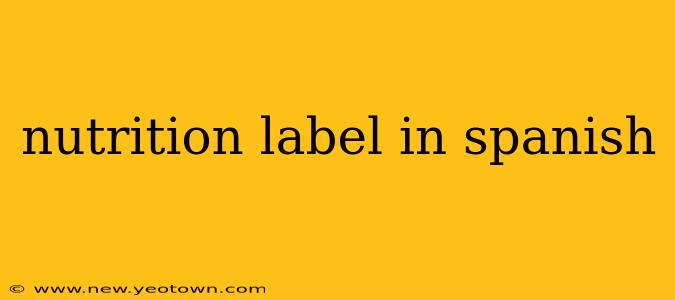Navigating a grocery store in a Spanish-speaking country can be an adventure, especially when trying to make healthy choices. But fear not! Once you understand the Spanish nutrition label, selecting nutritious foods becomes much easier. This guide will walk you through the key components, demystifying the process and empowering you to make informed decisions about your diet.
Imagine this: you're in a bustling mercado in Mexico City, surrounded by vibrant fruits, flavorful cheeses, and tempting pastries. You pick up a package of your favorite crackers, but the label is in Spanish. Don't worry—let's decipher it together!
What are the key elements of a Spanish Nutrition Label?
Spanish nutrition labels, while varying slightly depending on the country, generally follow a similar format to those in the United States or the European Union. They'll always include information about the serving size (Tamaño de la porción), the number of servings per container (Porciones por envase), and a breakdown of the nutrients (Nutrientes) per serving. The key components you need to focus on are:
-
Valor Energético (Energy Value): This is equivalent to "calories" and shows the amount of energy provided by the food. It’s usually measured in kilocalories (kcal) or kilojoules (kJ).
-
Grasas (Fat): This section will break down the different types of fats:
- Grasas Totales (Total Fat): The total amount of fat in the serving.
- Grasas Saturadas (Saturated Fat): A type of fat that can raise cholesterol levels. Limiting saturated fat is often recommended.
- Grasas Trans (Trans Fat): An especially unhealthy type of fat; ideally, you'll want to find products with minimal or no trans fats.
- Grasas Insaturadas (Unsaturated Fat): These are generally considered healthier fats. This category is often not as explicitly detailed.
-
Carbohidratos (Carbohydrates): This section includes:
- Carbohidratos Totales (Total Carbohydrate): The total amount of carbohydrates.
- Azúcares (Sugars): Added sugars, naturally occurring sugars (like in fruit), or a combination. Pay close attention to added sugars.
- Fibra (Fiber): An essential nutrient for digestion and overall health.
-
Proteínas (Protein): Shows the amount of protein in the serving. Protein is crucial for building and repairing tissues.
-
Sal/Sodio (Salt/Sodium): Excessive sodium intake can contribute to high blood pressure.
How much of each nutrient should I be aiming for?
This is where things get a bit more nuanced. The recommended daily intake of each nutrient varies depending on factors like age, sex, activity level, and overall health. It’s always best to consult a doctor or registered dietitian for personalized recommendations. However, general guidelines often involve aiming for a balanced intake of all macronutrients (carbohydrates, fats, and proteins) while keeping added sugars and saturated/trans fats low. Look for foods with higher fiber and lower sodium content.
What do all those percentages mean? (VD or %VD)
Many Spanish nutrition labels also include a percentage value (%VD or Valor Diario) indicating the percentage of the recommended daily intake for a particular nutrient provided by one serving. These percentages are usually based on a 2000-calorie diet, but remember, this is just a general guideline.
Are there any differences between Spanish-language labels in different countries?
While the core information remains consistent, minor variations may exist in the specific terminology or the order of information presented. For instance, some countries might use different names for certain nutrients or units of measurement. However, the general principles remain the same across different Spanish-speaking regions.
How can I use this information to make healthy choices?
By understanding the information on the Spanish nutrition label, you can compare different products and make informed decisions that align with your dietary goals. Start by focusing on the key components mentioned earlier, paying close attention to added sugars, saturated fats, and sodium. Choose foods that are higher in fiber and protein and provide a balanced intake of nutrients.
Learning to read a Spanish nutrition label is a skill that will serve you well on your journey to healthier eating. With a little practice, navigating the grocery store in any Spanish-speaking country will become much easier and more enjoyable!

